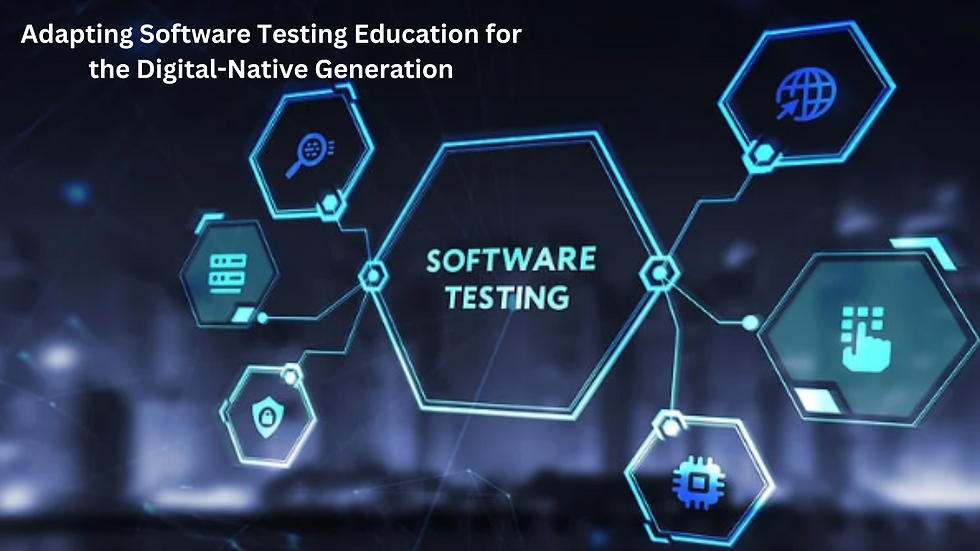Adapting Software Testing Education for the Digital-Native Generation
- Vaishali pal

- Aug 20, 2024
- 4 min read

The digital-native generation, often referred to as Generation Z, has grown up immersed in technology. With smartphones, social media, and the internet as integral parts of their daily lives, they possess a unique relationship with technology that previous generations did not have. This generational shift has significant implications for education, particularly in specialized fields like software testing. To effectively educate this tech-savvy cohort, we must adapt our teaching methods and curricula to align with their learning preferences and technological fluency.
Understanding the Digital-Native Generation
Before delving into how software testing education can be adapted, it’s essential to understand the characteristics of the digital-native generation. These individuals, born roughly between the mid-1990s and early 2010s, are characterized by their comfort with digital devices, preference for visual content, and tendency to multitask. They are accustomed to instant access to information and often prefer learning methods that are interactive and collaborative. Traditional education models, which are often lecture-based and linear, may not resonate as effectively with this group.
Challenges in Traditional Software Testing Education
Software testing is a critical component of software development, ensuring that applications work as intended and are free of bugs. However, traditional software testing education has often been rooted in theoretical concepts and manual testing methods. While these fundamentals are essential, they may not fully engage the digital-native generation, who are used to more dynamic and hands-on experiences.
1. Lack of Engagement: Traditional lecture-based methods may fail to capture the attention of digital natives, who prefer more interactive and engaging learning environments. The lack of practical, real-world applications in the curriculum can make the subject matter seem abstract and disconnected from their day-to-day experiences with technology.
2. Outdated Tools and Techniques: The pace of technological advancement means that the tools and techniques used in software testing are constantly evolving. However, many educational programs still rely on outdated tools or do not integrate the latest industry practices. This gap can leave students feeling unprepared for the modern workplace.
3. Insufficient Collaboration and Teamwork Opportunities: Digital natives thrive in collaborative environments where they can work together, share ideas, and solve problems collectively. Traditional education models that focus on individual achievement may not provide enough opportunities for teamwork and collaboration, which are crucial skills in the software testing field.
Strategies for Adapting Software Testing Education
To effectively teach software testing to the digital-native generation, educators need to adopt a more flexible, interactive, and up-to-date approach. Here are some strategies that can help:
1. Incorporate Gamification and Interactive Learning Tools
Gamification is the use of game design elements in non-game contexts, and it can be a powerful tool in education. By incorporating elements like points, badges, and leaderboards into the software testing curriculum, educators can make learning more engaging and enjoyable. Interactive learning tools, such as simulation software or online coding platforms, can also provide students with hands-on experience, allowing them to apply theoretical concepts in a practical setting.
2. Emphasize Real-World Applications
To make software testing more relevant to digital natives, educators should focus on real-world applications of the concepts being taught. This could involve using case studies of well-known software failures, discussing current trends in the tech industry, or even involving students in live projects where they can test real software. By connecting the curriculum to real-world scenarios, students are more likely to see the value of what they are learning and be motivated to engage with the material.
3. Integrate the Latest Tools and Technologies
The software testing landscape is continuously evolving, with new tools and technologies emerging regularly. Educators should ensure that their curriculum reflects these changes by incorporating the latest industry-standard tools, such as automated testing frameworks, continuous integration/continuous deployment (CI/CD) pipelines, and cloud-based testing environments. By familiarizing students with these tools during their education, they will be better prepared to enter the workforce and contribute effectively from day one.
4. Foster Collaboration and Teamwork
In the modern software development environment, collaboration is key. Educators should encourage students to work together on projects, participate in peer code reviews, and engage in group discussions. Collaborative learning not only mirrors the real-world work environment but also helps students develop critical communication and teamwork skills. Online platforms and collaborative tools like GitHub, Jira, or Slack can be integrated into the curriculum to facilitate group work and communication.
5. Provide Continuous Feedback and Adaptive Learning
Digital natives are accustomed to receiving instant feedback, whether it’s through social media or other digital platforms. In the educational context, providing continuous feedback on assignments, quizzes, and projects can help students understand their progress and areas for improvement. Adaptive learning technologies, which adjust the content and difficulty level based on individual performance, can also be used to tailor the learning experience to each student’s needs.
6. Embrace a Blended Learning Approach
Blended learning, which combines online digital media with traditional classroom methods, is particularly well-suited to the digital-native generation. By offering a mix of online lectures, interactive exercises, and in-person discussions, educators can cater to different learning styles and provide a more flexible learning environment. This approach also allows students to learn at their own pace, revisiting challenging topics as needed.
Conclusion
Adapting software testing education for the digital-native generation is not just about incorporating more technology into the classroom; it’s about rethinking how we teach and what we teach. By understanding the unique characteristics of this generation and implementing strategies that align with their learning preferences, educators can create a more engaging, relevant, and effective learning experience. Incorporating this modern approach in a Software Testing Course in Delhi, Noida, Mumbai, Thane, Vadodara and other cities across India can significantly enhance the preparedness of students for successful careers in software testing and contribute to the ongoing evolution of the tech industry as a whole.


